The Impact of Color Blindness on Player Engagement and Emotional Experiences: A Multimodal Study in a Game-Based Environment
Abstract
1. Introduction
- How does color blindness influence the emotional experience of players in digital games?
- To what extent and in what ways does color blindness affect player engagement compared to individuals with normal vision?
“Color-blind individuals face significant disadvantages in the context of digital games compared to those with normal vision in terms of (1) engaging with the game world and (2) emotional experience.”
2. Methodology
2.1. Conducting the Experiment
2.1.1. Participant Profile and Sampling Strategy
2.1.2. Experimental Setup: Designing the Game-Based Environment
- Find Level: Players explore a static forest scene populated by monsters. The goal is to identify and tap on “foreign” monsters whose colors do not match the dominant color scheme of the island. This level emphasizes visual discrimination and perceptual focus in a low-pressure setting.
- Runner Level: Players control forward movement using a tap-to-walk mechanic while colored monsters appear along the path. Players must tap and remove those incongruent with the island’s designated color, encouraging reflexive recognition and decision-making under mild time pressure.
- Catching Objects Level: Monsters appear and disappear dynamically from the screen. Players must only tap those that match the level’s intended color profile, requiring focused attention and fast visual judgment.
2.2. Data Analysis
2.2.1. Emotion AI Analysis
2.2.2. Survey
2.2.3. Screen Recording
3. Results
3.1. Facial Emotion Recognition Results
3.1.1. Emotion Distribution
3.1.2. Engagement over Time
3.2. Survey Results
3.3. Screen Recording: Player Engagement-Oriented Performance Indicators
3.3.1. Completion Time and Number of Mistakes
3.3.2. Round Preference
4. Discussion
4.1. Emotional Experience
4.2. Player Engagement
4.3. Implications for Inclusive Design and Future Research
4.4. Limitations and Future Directions
5. Conclusions
Supplementary Materials
Author Contributions
Funding
Institutional Review Board Statement
Informed Consent Statement
Data Availability Statement
Acknowledgments
Conflicts of Interest
References
- Chai, M.T.; Amin, H.U.; Izhar, L.I.; Saad, M.N.M.; Abdul Rahman, M.; Malik, A.S.; Tang, T.B. Exploring EEG effective connectivity network in estimating influence of color on emotion and memory. Front. Neuroinformatics 2019, 13, 66. [Google Scholar] [CrossRef] [PubMed]
- Pinheiro, M.; Viana, W.; de Gois Ribeiro Darin, T. Why should red and green never be seen? Exploring color blindness simulations as tools to create chromatically accessible games. Proc. ACM Hum.-Comput. Interact. 2023, 7, 165–196. [Google Scholar] [CrossRef]
- Molina-López, J.; Medina-Medina, N. Design proto-patterns to improve the interaction in video games of people with color blindness. In Proceedings of the XX International Conference on Human Computer Interaction, Donostia Gipuzkoa, Spain, 25–28 June 2019; Association for Computing Machinery: New York, NY, USA, 2019. [Google Scholar] [CrossRef]
- Napoli, D.; Chiasson, S. Exploring the Impact of Colour-Blindness on Computer Game Performance. In Proceedings of the Extended Abstracts of the 2018 CHI Conference on Human Factors in Computing Systems, Montreal, QC, Canada, 21–26 April 2018; Association for Computing Machinery: New York, NY, USA, 2018. [Google Scholar] [CrossRef]
- Kerac, J.; Keresteš, N.M.; Dedijer, S. An overview of the user experience in online video game players with colour vision deficiency. In Proceedings of the 11th International Symposium on Graphic Engineering and Design, Novi Sad, Serbia, 3–5 November 2022; pp. 281–291. [Google Scholar] [CrossRef]
- Yu, D. See a Different World: Interactive Storytelling for Children to Raise Awareness of Color Blindness. Master’s Thesis, Rochester Institute of Technology, Rochester, NY, USA, 2015. [Google Scholar]
- Baalsrud Hauge, J.; Judd, N.; Stefan, I.A.; Stefan, A. Perspectives on accessibility in digital games. In Entertainment Computing–ICEC 2018: 17th IFIP TC 14 International Conference, Held at the 24th IFIP World Computer Congress, WCC 2018, Poznan, Poland, 17–20 September 2018, Proceedings; Springer International Publishing: Heidelberg/Berlin, Germany, 2018; pp. 402–406. [Google Scholar]
- Plothe, T. The Whose View of Hue?: Disability adaptability for color blindness in the digital game Hue. GAME Games Art Media Entertain. 2018, 1, 41–51. [Google Scholar]
- Nguyen, L.C.; Do, E.Y.L.; Chia, A.; Wang, Y.; Duh, H.B.L. DoDo game, a color vision deficiency screening test for young children. In Proceedings of the SIGCHI Conference on Human Factors in Computing Systems, Toronto, ON, Canada, 26 April–1 May 2014; Association for Computing Machinery: New York, NY, USA, 2014; pp. 2289–2292. [Google Scholar]
- Paiva, I.M.; Siqueira, S.; Ferreira, S.B.L. The Windows 10’s Color Filter Feature as an Aid for Color Blind People in the Use of Websites. In Proceedings of the XX Brazilian Symposium on Human Factors in Computing Systems, Virtual, 18–22 October 2021; Association for Computing Machinery: New York, NY, USA, 2021; pp. 1–11. [Google Scholar]
- Pinheiro, M.; Viana, W.; Andrade, R.; Darin, T. Flying colors: Using color blindness simulations in the development of accessible mobile games. In Proceedings of the XX Brazilian Symposium on Human Factors in Computing Systems, Virtual, 18–22 October 2021; Association for Computing Machinery: New York, NY, USA, 2021. [Google Scholar] [CrossRef]
- Elliot, A.J.; Maier, M.A. Color psychology: Effects of perceiving color on psychological functioning in humans. Annu. Rev. Psychol. 2014, 65, 95–120. [Google Scholar] [CrossRef] [PubMed]
- Valdez, P.; Mehrabian, A. Effects of color on emotions. J. Exp. Psychol. Gen. 1994, 123, 394–409. [Google Scholar] [CrossRef] [PubMed]
- Kaya, N.; Epps, H. Relationship between color and emotion: A study of college students. Coll. Stud. J. 2004, 38, 396. [Google Scholar]
- Uusküla, M.; Mohr, C.; Epicoco, D.; Jonauskaite, D. Is Purple Lost in Translation? The Affective Meaning of Purple, Violet, and Lilac Cognates in 16 Languages and 30 Populations. J. Psycholinguist. Res. 2022, 52, 853–868. [Google Scholar] [PubMed]
- Jonauskaitė, D.; Camenzind, L.; Párraga, C.; Diouf, C.; Ducommun, M.; Müller, L.; Norberg, M.; Mohr, C. Colour-emotion associations in individuals with red-green colour blindness. PeerJ 2021, 9, e11180. [Google Scholar] [CrossRef] [PubMed]
- Geslin, E.; Jégou, L.; Beaudoin, D. How color properties can be used to elicit emotions in video games. Int. J. Comput. Games Technol. 2016, 2016, 182768. [Google Scholar] [CrossRef]
- Supplemental Video 1: Color Quest–One-Minute Gameplay Demonstration Video Showing Level Transitions, Core Mechanics, and Visual Environment. Available online: https://youtu.be/TfZYzSpX97w (accessed on 4 June 2025).
- Ekman, P. Basic emotions. In Handbook of Cognition and Emotion; Dalgleish, T., Power, M., Eds.; John Wiley & Sons: Hoboken, NJ, USA, 1999; pp. 45–60. Available online: https://www.paulekman.com/wp-content/uploads/2013/07/Basic-Emotions.pdf (accessed on 15 May 2025).
- Howell, N.; Hartsoe, W.F.; Amin, J.; Naman, V. Reflective Design for Informal Participatory Algorithm Auditing: A Case Study with Emotion AI. In Proceedings of the 13th Nordic Conference on Human-Computer Interaction, Uppsala Sweden, 13–16 October 2024; Georgia Institute of Technology; Association for Computing Machinery: New York, NY, USA, 2024. [Google Scholar]
- Glazunova, O.; Savytska, I.; Korolchuk, V.; Voloshyna, T. Information and Communication Technologies in Education, Research, and Industrial Applications. In Managing Student Engagement During the Educational Process Using the MorphCast AI Tool, Proceedings of 19th International Conference, ICTERI 2024, Lviv, Ukraine, 23–27 September 2024; Springer: Berlin/Heidelberg, Germany, 2024; CCIS; Volume 2359, pp. 133–145. [Google Scholar]
- Zignego, M.I.; Bertirotti, A.; Gemelli, P.A.; Pagani, L. Neurodesign: A Game-Changer in Educational Contexts. In Proceedings of the 7th International Conference for Design Education Researchers, London, UK, 29 November–1 December 2023. [Google Scholar]
- Avolicino, S.; Di Gregorio, M.; Palomba, F.; Romano, M.; Sebillo, M.; Vitiello, G. HCI International 2022-Late Breaking Papers. Design, User Experience and Interaction. In AI-Based Emotion Recognition to Study Users’ Perception of Dark Patterns, Proceedings of the 24th International Conference on Human-Computer Interaction, HCII 2022, Virtual Event, June 26–July 1 2022; Springer: Berlin/Heidelberg, Germany, 2022. [Google Scholar]
- Huang, X.; Romano, D.M. Coral Morph: An Artistic Shape-Changing Textile Installation for Mindful Emotion Regulation in the Wild. Int. J. Hum.–Comput. Interact. 2023, 41, 1173–1189. [Google Scholar] [CrossRef]
- Ekman, P. An argument for basic emotions. Cogn. Emot. 1992, 6, 169–200. [Google Scholar] [CrossRef]

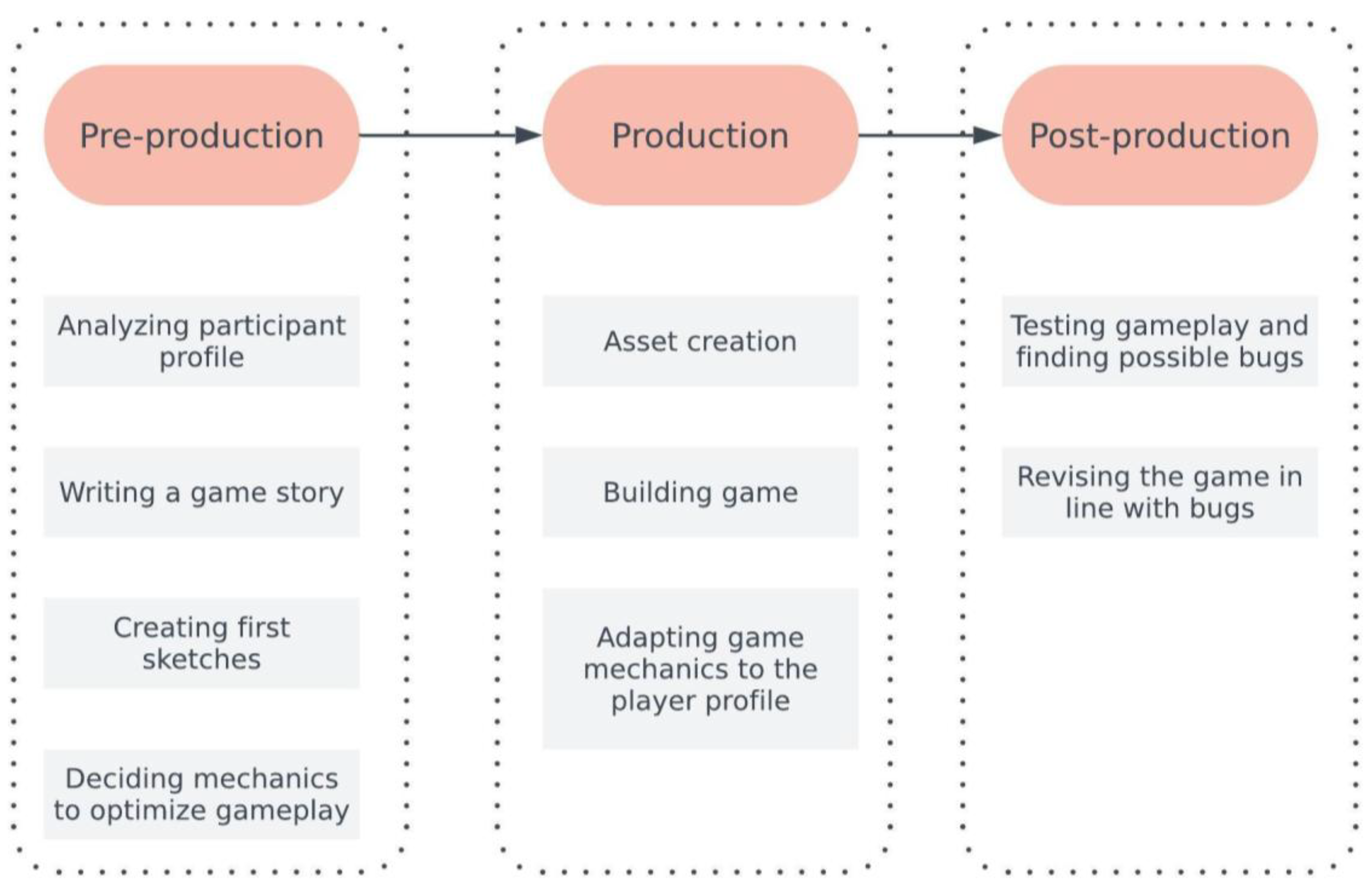

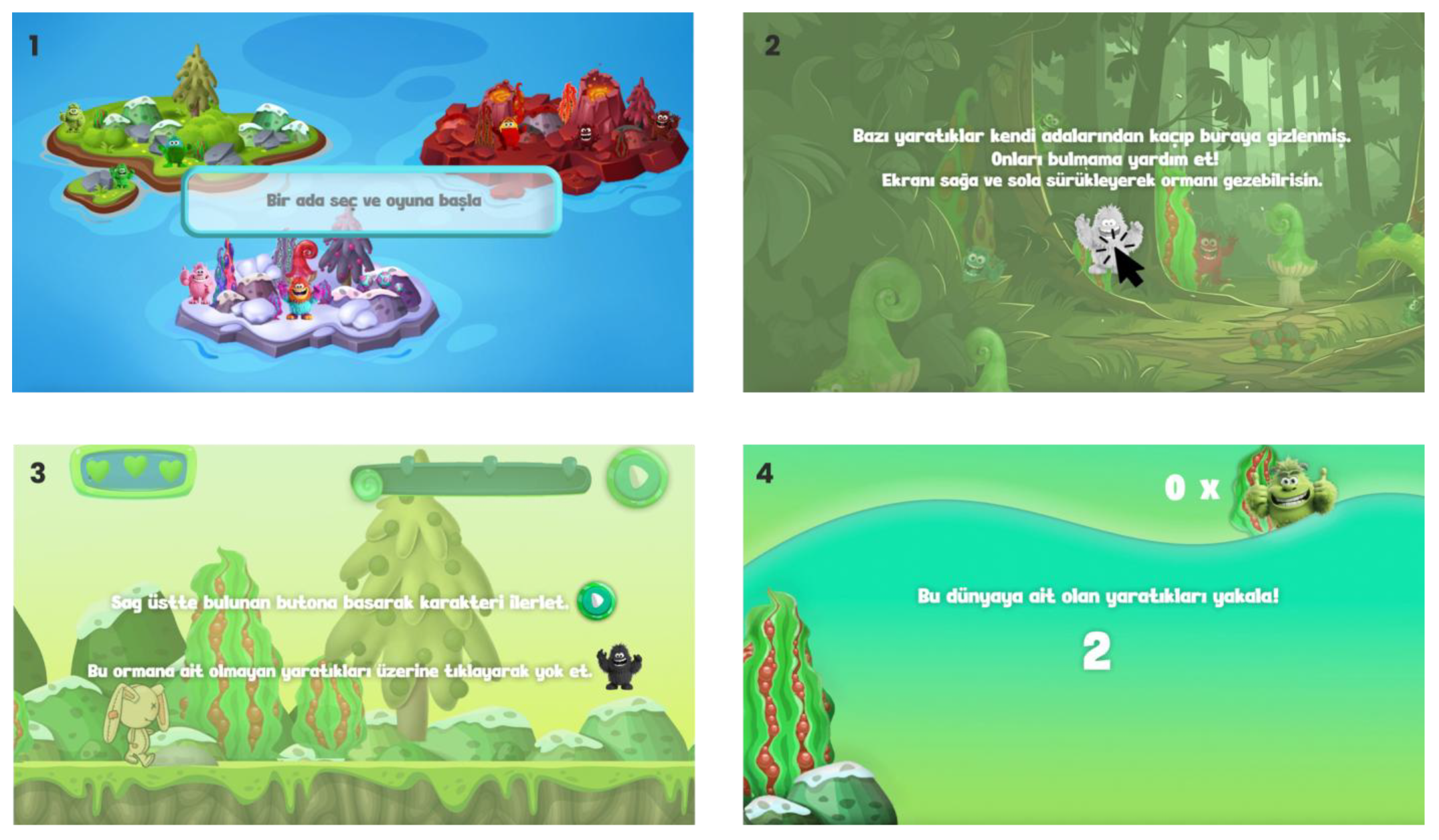
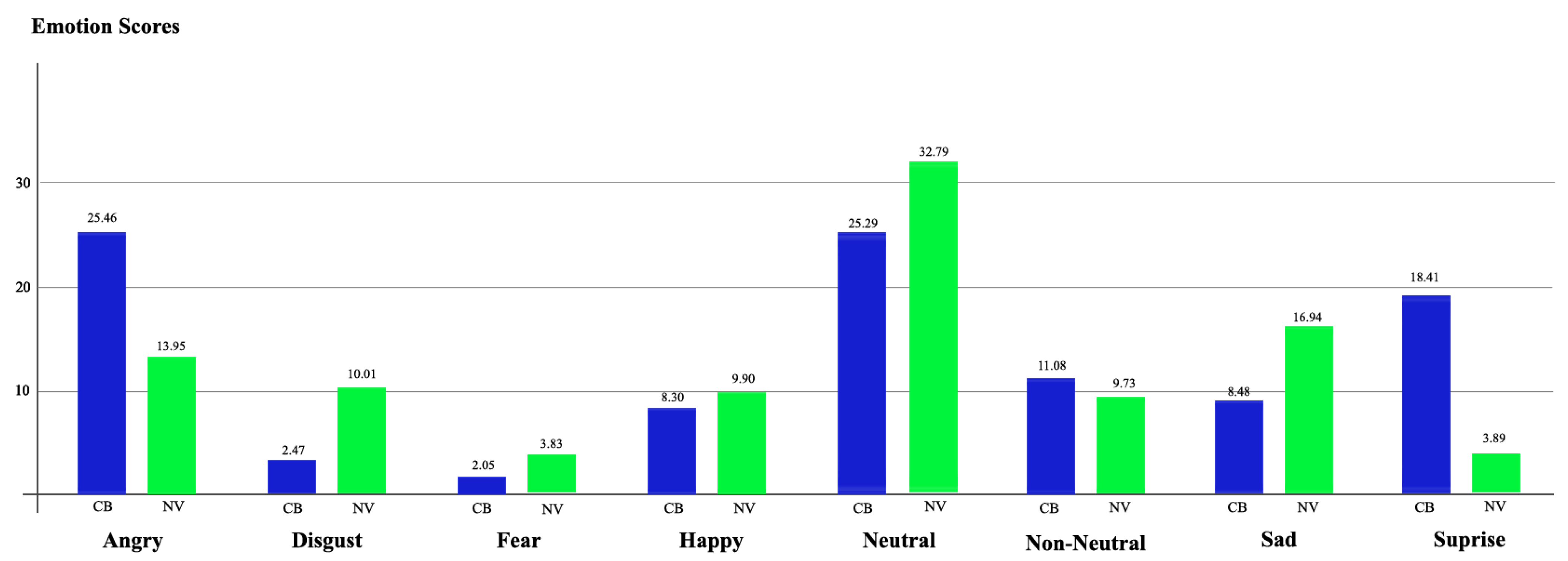
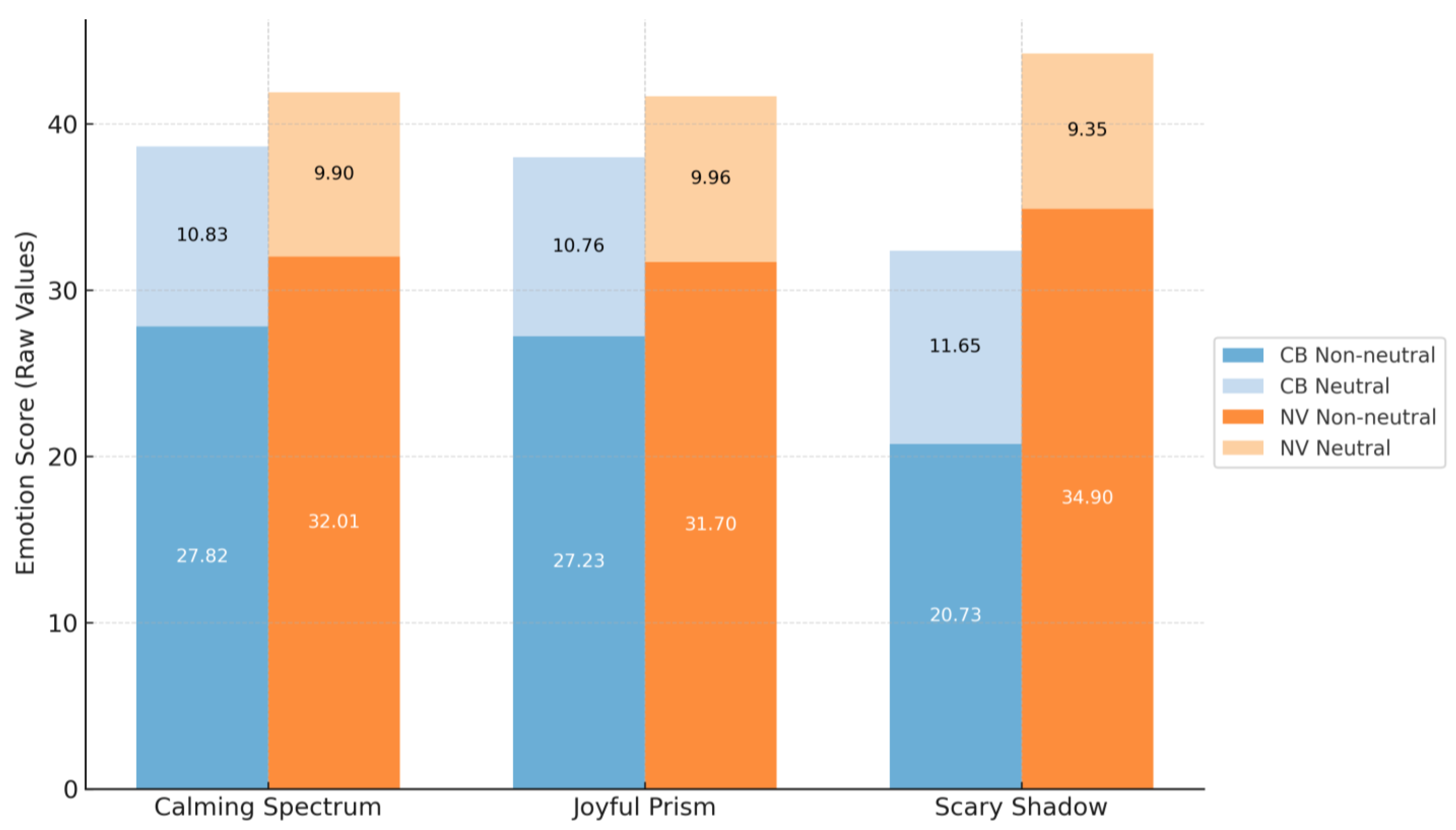
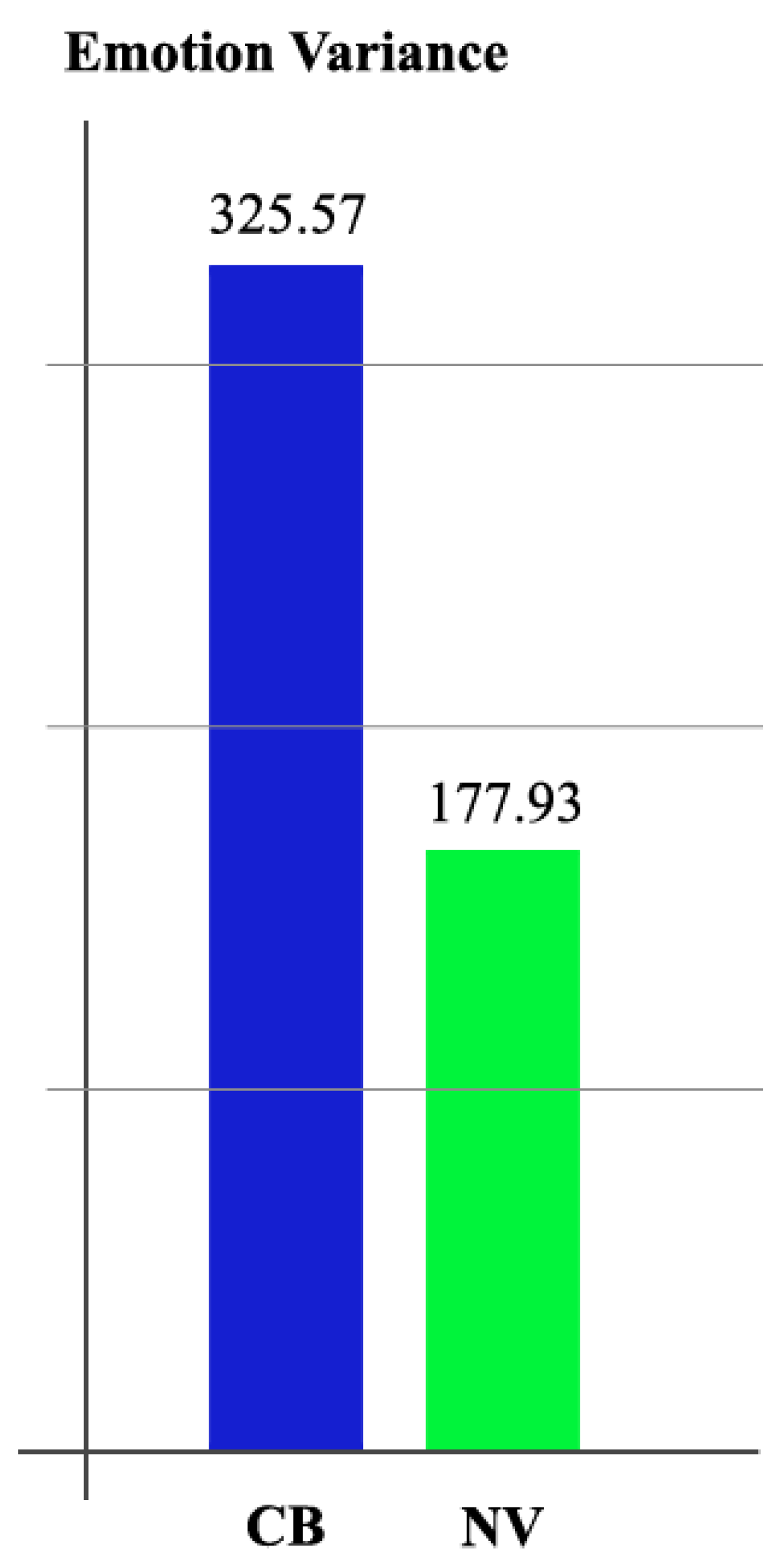
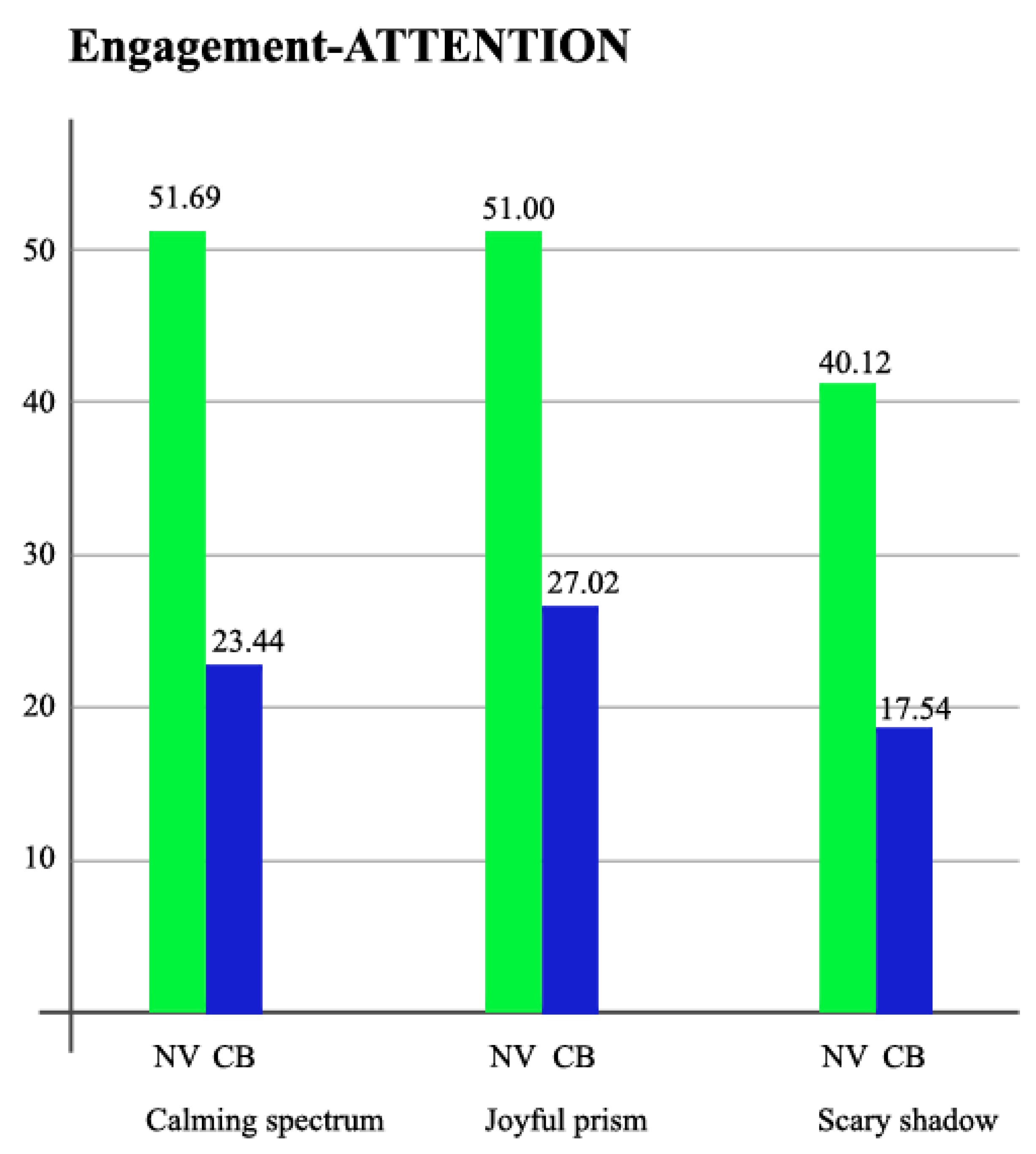
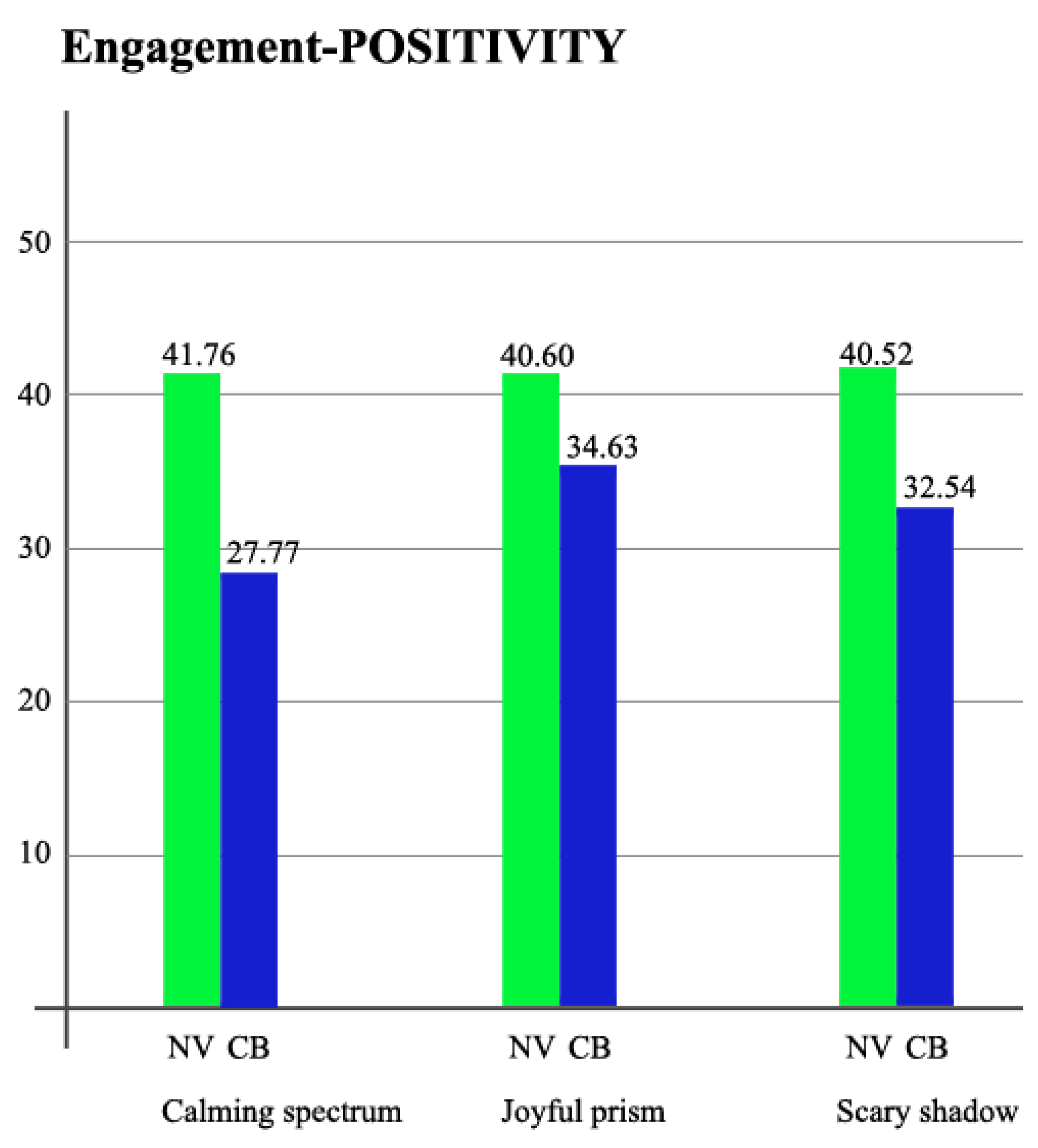
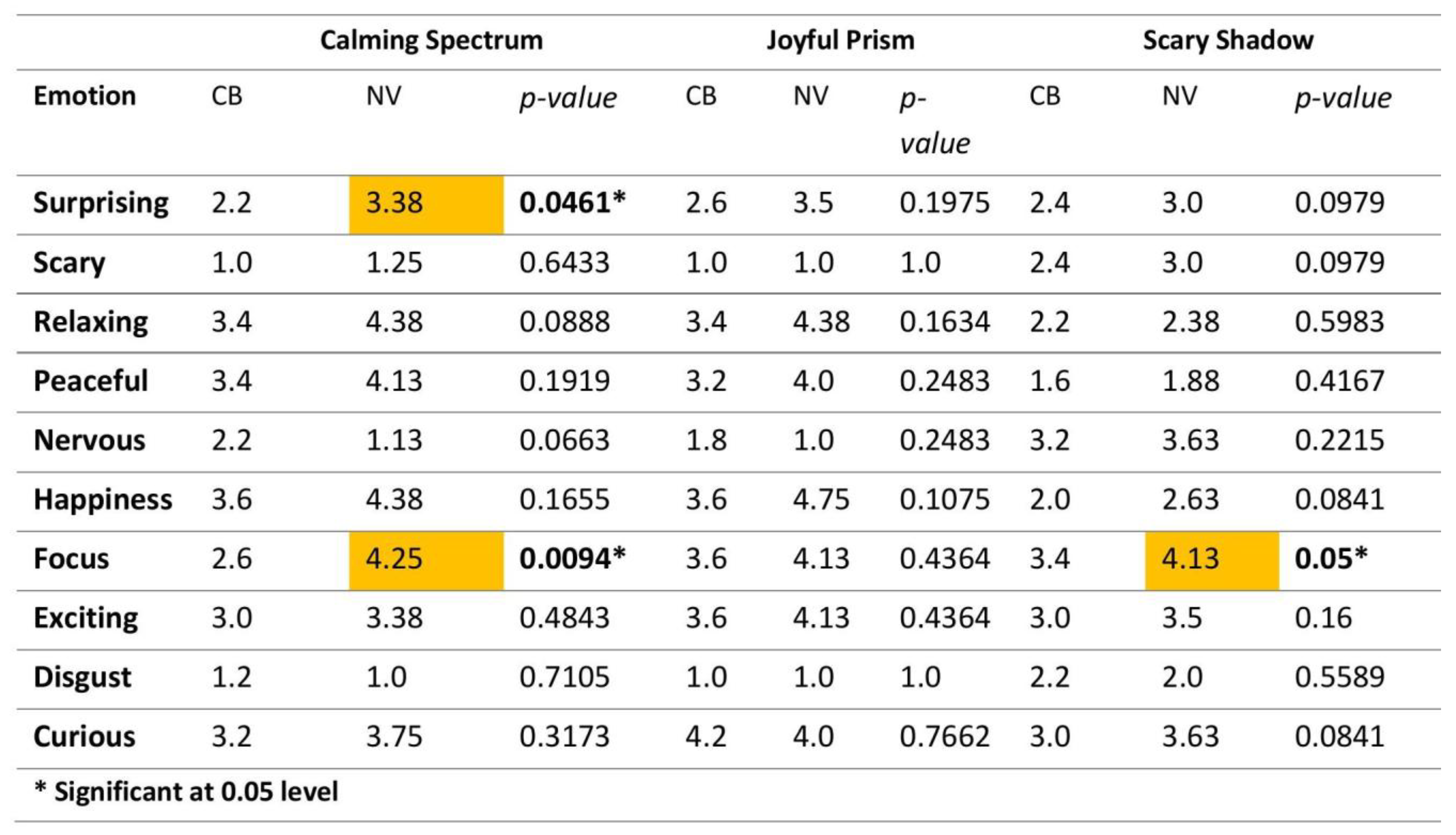


| Statistic | Value | df | Sig.2 (Two-Tailed) | Mean Difference |
|---|---|---|---|---|
| t-test | 0.012924524 | 64.11436488 | 0.989728143 | −0.040535714 |
| Game Section | Mean (CB) | SD (CB) | Mean (NV) | SD (NV) | Mean Difference | Standard Error (SE) | t-Value | p-Value |
|---|---|---|---|---|---|---|---|---|
| Calming Spectrum | 2.58 | 0.921 | 3.10 | 1.412 | −0.52 | 0.716 | −0.730 | 0.480358 |
| Joyful Prism | 2.80 | 1.151 | 3.19 | 1.542 | −0.39 | 0.805 | −0.483 | 0.638486 |
| Scary Shadow | 2.54 | 0.582 | 2.78 | 0.978 | −0.24 | 0.488 | −0.488 | 0.635127 |
| Overall Mean | 2.64 | 0.890 | 3.02 | 1.299 | −0.38 | 0.665 | −0.576 | 0.576407 |
Disclaimer/Publisher’s Note: The statements, opinions and data contained in all publications are solely those of the individual author(s) and contributor(s) and not of MDPI and/or the editor(s). MDPI and/or the editor(s) disclaim responsibility for any injury to people or property resulting from any ideas, methods, instructions or products referred to in the content. |
© 2025 by the authors. Licensee MDPI, Basel, Switzerland. This article is an open access article distributed under the terms and conditions of the Creative Commons Attribution (CC BY) license (https://creativecommons.org/licenses/by/4.0/).
Share and Cite
Tillem, M.; Gün, A. The Impact of Color Blindness on Player Engagement and Emotional Experiences: A Multimodal Study in a Game-Based Environment. Multimodal Technol. Interact. 2025, 9, 62. https://doi.org/10.3390/mti9060062
Tillem M, Gün A. The Impact of Color Blindness on Player Engagement and Emotional Experiences: A Multimodal Study in a Game-Based Environment. Multimodal Technologies and Interaction. 2025; 9(6):62. https://doi.org/10.3390/mti9060062
Chicago/Turabian StyleTillem, Merve, and Ahmet Gün. 2025. "The Impact of Color Blindness on Player Engagement and Emotional Experiences: A Multimodal Study in a Game-Based Environment" Multimodal Technologies and Interaction 9, no. 6: 62. https://doi.org/10.3390/mti9060062
APA StyleTillem, M., & Gün, A. (2025). The Impact of Color Blindness on Player Engagement and Emotional Experiences: A Multimodal Study in a Game-Based Environment. Multimodal Technologies and Interaction, 9(6), 62. https://doi.org/10.3390/mti9060062








